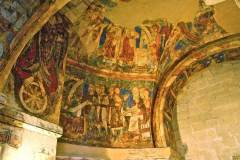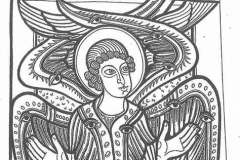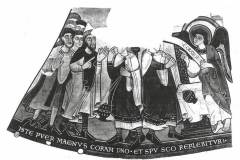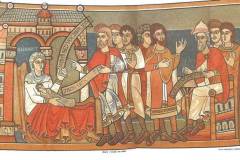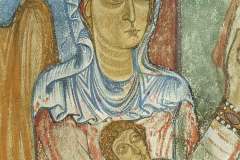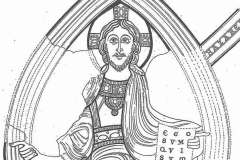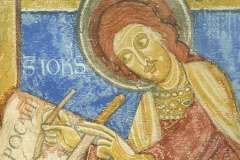These images, on the wall of the apse in St Gabriel’s chapel, can be seen today only because the area was walled up in the late 12th century – perhaps to provide a hiding place for the remains of Thomas Becket but more likely for purely structural reasons – and was only opened to modern eyes when a door was opened in the wall in 1879. The entire wall was demolished in the 1950s, and a major restoration took place in the 1990s. Tristram (1951) notes that ‘These paintings should certainly be ranked amongst the finest examples of Western European art of the twelfth century’. The scenes depicted, some badly faded but many in vivid colour, include a central image of Christ, the Annunciation of the birth of John the Baptist, Zacharias struck dumb, and many angels in support (overview Image 1)
What to see:
- one of many supporting angels (Image 2) – this is one of two extraordinary (apparently unique) six winged seraphim each with additional eyes in their wings and standing on a wheel, denoting ability to go anywhere quickly
- the 80 year old Zacharias is struck dumb (Image 3) – the upper part of the head of Zacharias is missing but he is clearly pointing to his mouth to indicate that he cannot speak
- the naming of John the Baptist (Image 4) – Elizabeth on the left holds the infant John the Baptist (Image 5) whilst Zacharias on the right sits in his chair and writes
- head of Christ with nimbus (halo) in the centre of the vault (Image 6) – much of this plaster has been damaged or lost due to its position high in the vault, but note surviving detail in the facial features and dress (neckpiece, tunic with jewellery, and stole)
- the underside of the arch on the far (eastern) wall, which surrounds a modern icon of the Annunciation (the work of Brother Luke of the Benedictine Abbey of Chevtogne placed here in 1985): the Seven Stars on a blue background at the top represent the seven churches of Asia – these are depicted in the neighbouring panels; the lower left panel shows the seated figure of John the Evangelist IMage 7) – at first sight he seems to be writing with both left and right hands, but the instrument in his left hand is a knife used to correct errors; John is writing the Apocalypse.
Sources: see standard sources; also Robertson, Canon Scott (1880) Arch Cant XIII The crypt of Canterbury Cathedral Part I; also Tristram (1951)
DL

